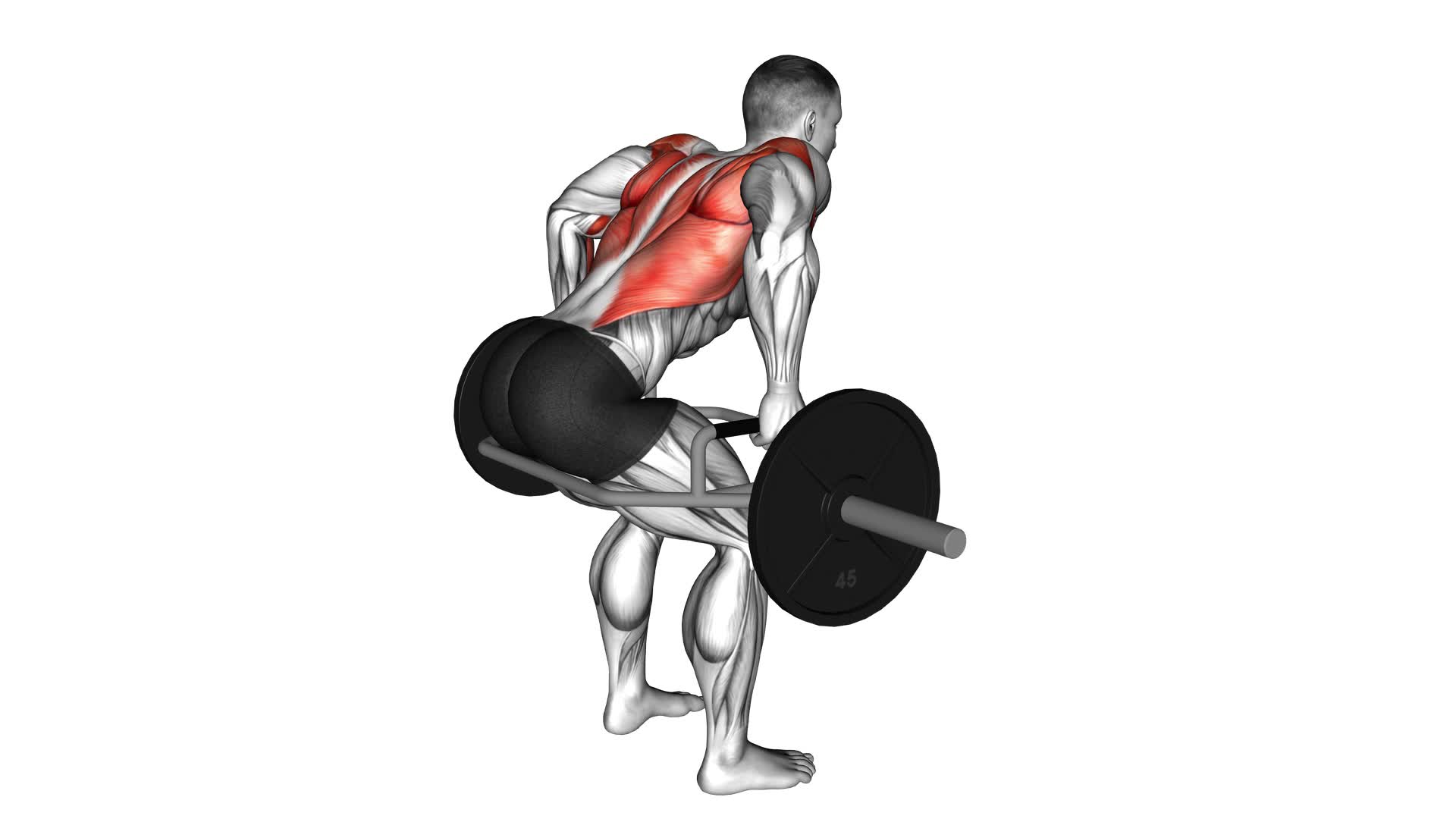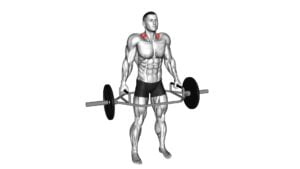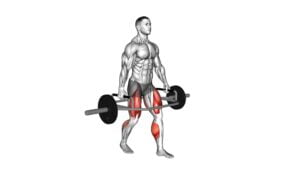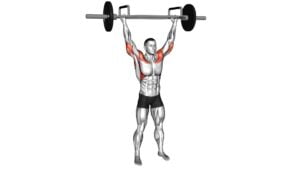Trap Bar Bent Over Row (male) – Video Exercise Guide & Tips

Looking to strengthen your back muscles? Check out this video exercise guide and tips for the trap bar bent over row.
Watch This Exercise Video
This compound exercise targets your lats, traps, and rhomboids, promoting better posture and increased upper body strength.
Learn the proper form, common mistakes to avoid, and variations to keep challenging yourself.
With these expert tips, you'll maximize your results and take your fitness game to the next level.
Let's get started!
Key Takeaways
- Trap Bar Bent Over Row targets lats, traps, and rhomboids, promoting better posture and increasing upper body strength.
- Proper form and range of motion are crucial, focusing on hip mobility, core stability, and maintaining a neutral spine.
- Using the right equipment, such as a trap bar with parallel handles set at the correct height, ensures a secure hold and supports proper technique.
- Avoid common mistakes like using improper grip, lifting excessive weight, and compromising technique, as they can lead to injuries and reduced effectiveness.
Benefits of Trap Bar Bent Over Row
To maximize your gains, incorporate the trap bar bent over row into your workout routine for a stronger and more defined upper body. This exercise offers numerous benefits, including improving posture and developing upper back strength.
One of the key advantages of the trap bar bent over row is its ability to improve posture. As you perform this exercise, you engage the muscles in your upper back, which helps to pull your shoulders back and prevent slouching. By consistently incorporating this row into your routine, you can develop better posture over time.
Additionally, the trap bar bent over row is highly effective for developing upper back strength. This exercise targets the muscles in your rhomboids, trapezius, and latissimus dorsi. As you pull the bar towards your body, you're engaging these muscles, which leads to increased strength and muscle definition in your upper back.
Proper Form for Trap Bar Bent Over Row
When performing the trap bar bent over row, it's crucial to focus on proper hip and back alignment to avoid strain or injury.
Additionally, ensuring a correct grip and hand placement will allow for optimal muscle engagement and control during the exercise.
Lastly, paying attention to the range of motion will ensure that you're effectively targeting the muscles in your back and arms.
Hip and Back Alignment
To ensure proper form for the Trap Bar Bent Over Row, it's important for you to maintain correct hip and back alignment. This won't only maximize the effectiveness of the exercise but also help prevent injuries.
Here are some tips to help you achieve the right alignment:
- Focus on hip mobility: Make sure your hips are mobile enough to allow for a full range of motion during the exercise. This will help you engage the correct muscles and avoid compensatory movements.
- Engage core stability: Keep your core muscles activated throughout the movement. This will provide stability and support to your spine, preventing excessive rounding or arching of the back.
- Maintain a neutral spine: Avoid excessive rounding or arching of the back. Instead, aim to keep your spine in a neutral position throughout the exercise.
Grip and Hand Placement
Now let's delve into the proper grip and hand placement for the Trap Bar Bent Over Row, building on the previous discussion about hip and back alignment.
Having a strong grip is essential for this exercise, as it allows you to maintain control and lift heavier weights. To develop hand strength and forearm muscles, make sure to grip the handles of the trap bar firmly.
Your hands should be slightly wider than shoulder-width apart, with the palms facing your body. This grip allows for maximum engagement of the back muscles during the rowing movement. By focusing on proper hand placement, you can ensure that you're targeting the right muscles and maximizing your results.
Now that you have a solid grip, let's move on to discussing the range of motion in the next section.
Range of Motion
To ensure proper form for the Trap Bar Bent Over Row, maintain a controlled and full range of motion throughout the exercise. Maximizing strength and muscle engagement requires executing the movement with precision.
Here are some key points to remember:
- Start by standing with your feet shoulder-width apart and grasping the handles of the trap bar.
- Keep your back straight and your core engaged as you hinge forward at the hips, allowing the bar to hang in front of you.
- Pull the bar towards your chest, leading with your elbows, while keeping your back flat and squeezing your shoulder blades together.
- Lower the bar back down in a controlled manner, fully extending your arms.
Equipment and Set-Up for Trap Bar Bent Over Row
Use the trap bar and set it up at a comfortable height for your bent over row. The trap bar, also known as a hex bar, is a versatile piece of equipment that allows for a more ergonomic grip and reduces stress on the lower back compared to a traditional barbell. When setting up the trap bar, ensure that the handles are parallel to the ground and at a height that allows you to maintain proper form throughout the exercise.
Equipment options for the trap bar bent over row include using a standard trap bar or one with raised handles, depending on your comfort and flexibility. Beginners can modify this exercise by using lighter weights and focusing on maintaining proper form rather than lifting heavy. This can help build strength and stability in the back muscles while reducing the risk of injury.
To begin the exercise, stand in the center of the trap bar with your feet shoulder-width apart. Hinge at your hips and lower your torso until it's parallel to the ground, keeping your back straight and core engaged. Grab the handles with an overhand grip and retract your shoulder blades. Pull the handles towards your chest, squeezing your shoulder blades together, and then slowly lower the weight back down to the starting position.
Remember to always warm up before starting any exercise and consult with a fitness professional if you have any concerns or questions about proper form or modifications.
Common Mistakes to Avoid in Trap Bar Bent Over Row
When performing the trap bar bent over row, it's important to avoid common mistakes that can lead to incorrect form and potential dangers.
One common mistake to avoid is using improper grip, as this can compromise your technique and put unnecessary strain on your wrists and forearms.
Additionally, it's crucial to avoid using excessive weight that you can't control, as this can increase the risk of injury and make it difficult to maintain proper form throughout the exercise.
Remember to prioritize safety and focus on maintaining proper technique to maximize the effectiveness of the trap bar bent over row.
Incorrect Form Dangers
Avoiding incorrect form in the trap bar bent over row is crucial to prevent potential injuries and maximize the effectiveness of the exercise. Here are some dangers of incorrect form and tips to prevent them:
- Arching your back: This can strain your lower back and lead to injuries. Keep your back straight throughout the movement.
- Rounding your shoulders: This can put excessive stress on your shoulders and compromise your form. Keep your shoulders pulled back and down.
- Using momentum: Swinging the weight can reduce the effectiveness of the exercise and increase the risk of injury. Control the movement and focus on using your muscles.
Proper Grip Importance
To ensure proper form and avoid common mistakes in the trap bar bent over row, it's essential to maintain a secure grip on the bar. The importance of grip strength can't be overstated in this exercise. A strong grip allows you to hold onto the bar firmly, preventing it from slipping out of your hands and potentially causing injury.
Moreover, a solid grip enables you to maintain control and stability throughout the movement, allowing you to engage the targeted muscles more effectively. To increase your grip strength, incorporate exercises such as farmer's walks, dead hangs, and wrist curls into your routine. Additionally, using tools like grip strengtheners and hand grippers can help improve your grip strength over time.
Don't overlook the importance of a strong grip in the trap bar bent over row.
Avoiding Excessive Weight
To prevent injury and ensure proper form in the trap bar bent over row, it's crucial for you to maintain a secure grip on the bar throughout the exercise. Avoiding excessive weight is essential for avoiding injury and performing the exercise with proper technique.
Here are some common mistakes to avoid:
- Avoid using weights that are too heavy for you to handle comfortably. Start with a weight that allows you to maintain good form and gradually increase as you get stronger.
- Don't let your ego dictate the weight you use. It's better to use lighter weights and perform the exercise correctly than to risk injury by lifting too heavy.
- Be mindful of your body's limits and avoid overexertion. Push yourself, but listen to your body and stop if you feel pain or discomfort.
Variations and Progressions of Trap Bar Bent Over Row
To progress in your trap bar bent over row exercise, you can explore different variations that target specific muscle groups. Variations and progressions not only add variety to your workout routine but also enhance muscle activation and promote overall strength development.
One variation you can try is the single-arm trap bar bent over row. This variation focuses on unilateral movement, engaging your core and stabilizer muscles to a greater extent.
Another variation is the wide-grip trap bar bent over row. By widening your grip on the bar, you shift the emphasis from your lats to your upper back muscles, such as the rhomboids and trapezius.
Additionally, you can incorporate progressions into your trap bar bent over row routine to continually challenge your muscles. One progression is the explosive trap bar bent over row, where you perform the exercise with an explosive movement, emphasizing power and speed.
Another progression is the deficit trap bar bent over row, where you stand on a platform or step to increase the range of motion and further engage your back muscles.
Remember to always maintain proper form and gradually increase the intensity of your variations and progressions to avoid injury and maximize results.
Tips for Maximizing Results From Trap Bar Bent Over Row
To maximize your results from the trap bar bent over row, focus on maintaining proper form and gradually increasing the intensity of your workouts. Here are some tips to help you maximize muscle activation and optimize your programming and progression:
- Engage your core: Keep your core tight throughout the exercise to ensure stability and prevent any unnecessary strain on your lower back.
- Squeeze your shoulder blades: As you pull the trap bar towards your chest, focus on squeezing your shoulder blades together. This will help to activate the muscles in your upper back and increase the effectiveness of the exercise.
- Vary your grip: Experiment with different grip widths to target different muscle groups. A wider grip will emphasize the muscles in your upper back, while a narrower grip will engage your biceps more.
When it comes to programming and progression, start with a weight that allows you to perform the exercise with proper form for the desired number of repetitions. Gradually increase the weight as you become stronger and more comfortable with the movement. Aim to progressively overload your muscles by adding more weight, increasing the number of sets or repetitions, or reducing rest time between sets.
Remember to listen to your body and give yourself adequate recovery time between workouts to avoid overtraining. By following these tips, you can maximize your results from the trap bar bent over row and continue to make progress in your strength training journey.
Frequently Asked Questions
How Many Sets and Reps Should I Do for Trap Bar Bent Over Rows?
For trap bar bent over rows, the ideal rep range is typically between 8 to 12 reps per set. This range allows you to build strength and muscle while maintaining proper form.
The benefits of trap bar bent over rows include targeting your back muscles, improving posture, and enhancing overall upper body strength. Incorporating this exercise into your routine can help you achieve a well-rounded and strong physique.
Remember to start with a weight that challenges you but still allows for proper technique.
Can Trap Bar Bent Over Rows Help Improve My Deadlift?
Trap bar bent over rows can be a great addition to your workout routine. They can help improve your deadlift by targeting similar muscle groups like your back, shoulders, and arms.
While they can't completely replace traditional bent over rows, they offer unique benefits such as reduced strain on your lower back and increased stability.
Incorporating trap bar bent over rows into your routine can enhance your overall strength and help you achieve better deadlift performance.
What Muscles Are Primarily Targeted During Trap Bar Bent Over Rows?
When you perform trap bar bent over rows, you primarily target your back muscles, specifically the latissimus dorsi, rhomboids, and trapezius. Incorporating this exercise into your workout routine can provide several benefits, including increased upper body strength, improved posture, and enhanced pulling power for exercises like deadlifts.
To target different muscle groups, you can vary your grip width or use different hand placement, such as underhand or neutral grip.
Can I Perform Trap Bar Bent Over Rows if I Have Lower Back Issues?
If you have lower back issues, it's important to modify your trap bar bent over rows to avoid further strain. You can try using a lighter weight or reducing the range of motion to lessen the pressure on your lower back.
Additionally, there are alternative exercises you can do that target similar muscles without as much stress on the lower back.
Consult with a fitness professional for personalized recommendations based on your specific condition.
Is It Necessary to Use a Trap Bar for Bent Over Rows, or Can I Use a Regular Barbell Instead?
Using a trap bar for bent over rows has several benefits. It allows for a more neutral grip, reducing strain on your wrists and elbows. The wider grip also targets your upper back muscles more effectively.
However, if you don't have access to a trap bar, you can still perform bent over rows with a regular barbell. Just make sure to maintain a proper form, keeping your back straight and engaging your core.
Conclusion
In conclusion, the trap bar bent over row is a highly effective exercise for targeting the back muscles.
By maintaining proper form and avoiding common mistakes, you can maximize the benefits of this exercise.
Additionally, incorporating variations and progressions can help to continually challenge your muscles and promote growth.
By following these tips, you can achieve optimal results from the trap bar bent over row.

Author
Years ago, the spark of my life’s passion ignited in my mind the moment I stepped into the local gym for the first time. The inaugural bead of perspiration, the initial endeavor, the very first surge of endorphins, and a sense of pride that washed over me post-workout marked the beginning of my deep-seated interest in strength sports, fitness, and sports nutrition. This very curiosity blossomed rapidly into a profound fascination, propelling me to earn a Master’s degree in Physical Education from the Academy of Physical Education in Krakow, followed by a Sports Manager diploma from the Jagiellonian University. My journey of growth led me to gain more specialized qualifications, such as being a certified personal trainer with a focus on sports dietetics, a lifeguard, and an instructor for wellness and corrective gymnastics. Theoretical knowledge paired seamlessly with practical experience, reinforcing my belief that the transformation of individuals under my guidance was also a reflection of my personal growth. This belief holds true even today. Each day, I strive to push the boundaries and explore new realms. These realms gently elevate me to greater heights. The unique combination of passion for my field and the continuous quest for growth fuels my drive to break new ground.







